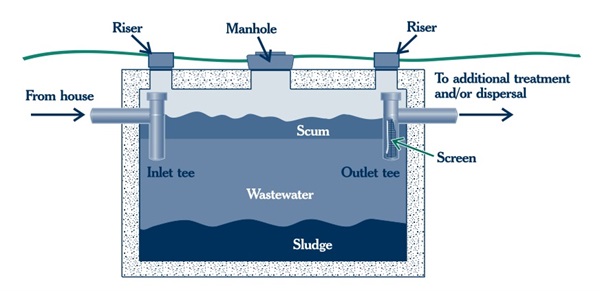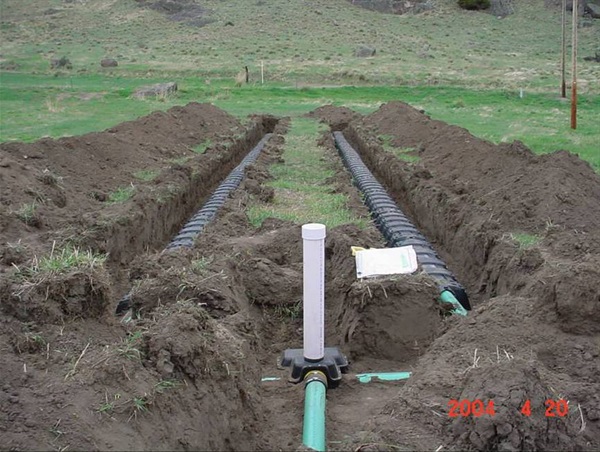The Environmental Services Division works with property owners to properly site and permit septic systems in Lewis and Clark County for new and replacement systems.
Properly sited, installed, and maintained septic systems protect groundwater supplies, the public's health, and your property investment.
Permitted Septic Systems
A site evaluation is an evaluation of the soils, topography, measurements, and water quality reviews for your parcel of land to determine what type of septic system, if any, is appropriate at that location.
Do I need a Site Evaluation?
Yes, I need one if:
- Developing an undeveloped parcel
- Altering, or replacing an existing septic system
- Adding a new septic system to a parcel
No, I don't need one if:
- I have a DEQ Subdivision Approval
- I have a previous site approval that meets current regulations
Ready to Apply? Start HERE Online Site Evaluation Application
Fees & Expectations
Fees
- New site, including Non-Degradation Review: $480
- Replacement system or a Review of Existing System: $400
- Individual Non-Degradation Review: $80
What to expect after I apply and pay my fees:
- A sanitarian will contact you by phone to schedule an onsite visit. Please allow up to one week from the time of application to receive a phone call.
- The Department has up to 20 working days from the time of application to approve or deny a site evaluation.
Applicant Responsibilities
1. Arrange to have a test hole dug at the time of the site evaluation.
2. If required, collect a water sample from the nearest well.
3. Have a general plan for the location of all facilities on your lot. This includes the main structure, driveways, shops, garden area, swimming pools, etc.
What is a Non-Degradation Review?
The Montana Water Quality Act requires that all new or increased sources of wastewater on a parcel of land in Montana cannot further contaminate or degrade groundwater or surface water.
What does this mean?
- To develop a parcel, Nitrate Sensitivity and Phosphorus Breakthrough to groundwater and surface water must be calculated.
- The applicant must collect a water sample from the nearest well and have it tested for nitrate and specific conductance.
- The lot cannot be approved for a septic system without a Non-degradation Review.
Other Site Restrictions & Considerations
Groundwater
- Groundwater cannot come to within 4 feet of the natural ground surface at any time of the year.
- Groundwater Monitoring may be required if there is evidence of a shallow groundwater table during the site evaluation.
Shallow Bedrock
- There must be at least 4 feet of naturally occurring soil between the bottom of the drain field trench and bedrock.
- The site may require more than 4 feet of soil depending on the site conditions.
Sanitary Restrictions
- Do you know what is allowed on your parcel?
- Some lots are subject to restrictions that do not allow you to develop the lot or change the existing use.
Engineered Design
- Your site may require an engineered design subject to the site evaluation
Unsure or have more questions? ASK! 406-447-8351
Septic permits are required for any residential or commercial structure requiring wastewater disposal that is not connected to a municipal sewer system.
The purpose of permitting septic systems is to ensure that sewage is properly disposed of in appropriate treatment systems in order to protect the public's health, surface water, and groundwater supplies.
The Environmental Division permits all, but not limited to, individual septic tanks with drain fields, individual septic tanks serving a community treatment system, holding tanks, and outhouses.
You MUST obtain a septic system permit prior to the start of ANY construction on the parcel. This includes drilling of the well or digging for the foundation. If construction starts prior to issuance of the septic permit, the permit fee will be doubled, and may include additional penalties.
To obtain a copy of an existing permit, contact our office at 406-447-8351 or via e-mail.
Am I ready to apply for a Permit?
Do NOT apply for a Permit unless:
- You have an approved Site Evaluation OR;
- You have a DEQ Certificate of Subdivision Approval OR;
- You have received verbal or written approval from the County Sanitarian.
Ready to Apply? Start HERE Online Septic Permit Application
What to expect once I apply
- Application will be processed, verified, and assigned to the Sanitarian.
- Sanitarian will review and write the permit. Allow approximately 5 working days.
- Sanitarian will notify applicant when the permit is ready via e-mail or telephone.
- Sanitarian will notify applicant of the fees and instructions for payment.
- Permit will be issued once payment is received, and construction can begin.
NOTE: Septic system permits expire one (1) year from the date of issuance. If the septic permit expires, a new septic system permit request must be submitted, paid for, and issued to the applicant.
Certified Septic Installers List(PDF, 947KB)
Fees for Septic Permits
Cert. Installer Non Cert. Installer
Standard Gravity System $160.00 $320.00
Pressure Dosed System $320.00 *******
Individual Engineered $480.00 *******
Multi User/Public $720.00 *******
Septic Tank Permit $ 80.00 $ 80.00
Holding Tank Permit $160.00 $160.00
(******) ONLY CERTIFIED INSTALLERS MAY INSTALL THESE SYSTEMS
Unsure or have more questions? ASK! 406-447-8351
Groundwater monitoring begins April 1 of each year. Some sites for a septic system may require that the groundwater level be monitored to make sure there is adequate separation from the drain field to the peak groundwater level. State and local rules require that groundwater cannot come to less than 4 feet of the natural ground surface at any time of the year within the boundary of the primary and replacement septic system area. In addition, the bottom of the drain field trench cannot be less than 4 feet to the highest groundwater level. Groundwater monitoring may be required if your site evaluation shows evidence that groundwater may be within 7 feet of the ground surface at any time of the year.
What is groundwater monitoring?
- Groundwater monitoring requires the installation of a monitoring well and the weekly measuring of groundwater levels by department staff.
- The "well" consists of a 12-foot section of 4-inch diameter, slotted PVC pipe.
- The pipe is then placed in the ground to a depth of 10 feet or greater.
- The top of the pipe is covered with a water tight cap.
How do I apply for groundwater monitoring?
- The groundwater monitoring fee is $720. You may install up to four groundwater monitoring wells per project.
- More than four wells requires an additional application and fee.
- To apply for groundwater monitoring, you must complete an Application before April 1. We accept some groundwater monitoring applications after the due date, but only on a case-by-case basis.
- Install the groundwater monitoring wells in the same area as the proposed primary and replacement drain field area.
- Provide notice to the Environmental Division that the monitoring well(s) have been installed.
Is there any other required information?
- Provide the location of the wells shown on a map. Basic Lot Layout(PDF, 51KB)
- Any access instructions such as gate, livestock, and other access restrictions.
Unsure or have more questions? ASK! 406-447-8351
Septic system installers in Lewis and Clark County must be certified by the County Health Department before installing certain types of wastewater treatment systems.
Certified Installer List 2024(PDF, 920KB)
How can I be Certified?
- Complete the application New Certified Installer Application
- Fee is $125 per calendar year
- All the testing materials and the exam will be sent to you via email
- Complete and pass the online exam with a minimum score of 80%
How do I renew my Certification?
Inspection of Wastewater Treatment Systems:
- When the septic system is 100% completed, and prior to final backfill, call the front office at 406-447-8351.
- Have the septic permit number ready and notify staff of the time and day that the system is ready for inspection. It is preferable to allow approximately 24 hours.
- Sanitarian will be notified and confirm the time and day.
Self-Inspection of Septic Systems:
- If the Sanitarian cannot inspect the system within 16 working hours, then they may allow a Certified Installer to do a self-inspection.
- Must be approved by the Sanitarian.
- Can only self-inspect standard, gravity-fed systems.
- Fill out the self-inspection form and submit it within 10 business days.
Resources:
DEQ Circular 4
Onsite Wastewater Regulations 2020(PDF, 604KB)
Unsure or have more questions? ASK! 406-447-8351
Before a local septic system permit can be issued for a parcel, there may be a requirement for a Montana Department of Environmental Quality (DEQ) Subdivision Review.
DEQ Subdivision Review is usually required for:
- Divisions of land less than 20 acres
- Parcels of land with sanitary restrictions cited on the Certificate of Survey
- Divisions of land for a family transfer
- Certain boundary line adjustments
- Condominiums, RV parks, and Trailer Courts, regardless of parcel size
Lewis and Clark County Public Health contracts with DEQ to review certain land uses on a parcel. This review is limited to sanitation facilities, including the water supply, sewage disposal, solid waste disposal, and storm water drainage systems.
Subdivisions are reviewed prior to creating the parcels to assure that adequate sanitation facilities can be constructed, operated, and maintained to support each parcel. Planning ahead for proper design and location of the facilities helps protect both our surface and groundwater in Montana.
Unsure or have more questions? ASK! 406-447-8351
Helpful Links:
Montana Department of Environmental Quality Subdivision website including all DEQ forms, applications, checklists, and calculations: DEQ Subdivisions
There are over 14,000 septic systems in Lewis and Clark County that discharge over 2 million gallons of wastewater (from toilets, showers, dishwashers, etc) into our groundwater each day.
Many of these septic systems are old and may not work properly. They have the potential to contaminate our groundwater. This creates a serious health hazard for those of us who rely on groundwater from wells for drinking, irrigating, washing, and other purposes.
That's why it's important for owners of septic systems to periodically inspect and pump their septic tanks - to make sure the systems are properly filtering disease-causing pathogens out of the wastewater.
The Septic Maintenance Program was established by the City-County Board of Health in 2011 in an effort to collaborate with septic system owners to help maintain their systems and protect public health. When you regularly monitor the operation and maintenance of your septic system through this program, you:
- help to protect your family and neighbors from diseases transmitted through wastewater;
- protect the quality of groundwater used for drinking and irrigating;
- extend the life of your septic system;
- help to avoid costly repairs; and
- meet local regulations.
Operation and Maintenance Providers List(PDF, 404KB)
Reporting Your Septic Maintenance Status
Under county Onsite Wastewater Treatment Regulations, you're expected to report the status of your septic system to the Health Department every 3-5 years, depending on how heavily you use the system and how often your tank needs to be pumped.
The Septic Maintenance Program is a phased approach, so reporting deadlines will vary from property to property. The Health Department will notify you by mail when your report is due.
You can choose to report using an online assessment form, or you can hire a certified independent operation and maintenance professional to inspect your septic system and submit your report for you.
If an inspection or self-assessment reveals problems with your septic system, the Health Department will work with you to resolve them.
Background
The ongoing development in Lewis and Clark County has had a cumulative effect on groundwater quality. Generally, individually maintained septic systems have a higher rate of failure than anticipated due to lack of maintenance including inspection and periodic pumping of the tanks.
In an effort to make sure these individual wastewater treatment systems function properly as well as to extend the life of many of these systems, the Environmental Protection Agency (EPA) has concluded that adequately managed decentralized wastewater systems are a cost-effective and long-term option for meeting public health and water quality goals, particularly in less densely populated areas.
The difference between failure and success is the implementation of an effective septic system management program. Such a program, if properly executed, can protect public health, preserve valuable water resources, and maintain economic vitality in a community.
Unsure or have more questions? ASK! 406-447-8351
Helpful Links:

Learn about the ins and outs of your septic system: SepticSmart Home (EPA)
Your Well and Septic System After a Fire(PDF, 576KB)
The Lewis and Clark County Septic System Revolving Loan Program provides low-interest loans to property owners who:
- have a septic system in need of repair or replacement; and
- meet income requirements.
The loan program is administered jointly by Lewis and Clark Public Health and the Montana Business Assistance Connection.
For more information or to see if you qualify, please contact us by e-mail or at 406-447-8351.
Frequently Asked Questions(PDF, 67KB)
Application Form(PDF, 99KB)
Completion of this form is one of two options you have for meeting requirements of the Lewis and Clark County On-site Wastewater Treatment Regulations(PDF, 604KB). Your second option is to hire a certified septic operation and maintenance service provider, who will submit an inspection report on your septic system to the health department for review.
How often a septic tank needs to be pumped depends on the system design and how your household uses the system. Complete this assessment to determine how often you should have your septic tank pumped.
Out of sight, but not out of mind
What happens when you run the dishwasher, flush the toilet or do a load of laundry?
Wastewater disposal is something we don't think too much about. So where does it all go?
A septic system is an integral part of your home and like your vehicle, it must be maintained. That means having your system regularly inspected by a professional and pumping your septic tank as needed.
Maintaining your septic system protects your
property investment and ensures clean drinking water
for you and your neighbors!
How to Maintain Your Drain Field
Taking Care of Your Groundwater (video)
Homeowner's Guide to Septic Systems(PDF, 3MB)
How to Extend the Life of Your Septic System(PDF, 1MB)
The Septic Tank
The septic tank is a watertight container usually made of concrete with an inlet and outlet pipe. The septic tank acts as a settling device where bacteria in the wastewater break down solids.
Solids heavier than water settle at the bottom of the tank and form sludge. Solids lighter than water (fats, oils and grease) float to the top forming a layer of scum. The middle layer is clear effluent that is carried out to the drainfield.
The sludge and scum is retained in the tank until it is pumped out by a licensed professional.
 Image Courtesy US Environmental Protection Agency
Image Courtesy US Environmental Protection Agency
Can't remember the last time you had your septic tank pumped? Protect your property investment. Have your septic tank regularly inspected by a professional and pumped as needed.
The Drainfield
The wastewater exits the septic tank and is discharged into the drainfield for further treatment by the soil. The partially treated wastewater is pushed along into the drainfield for further treatment every time new wastewater enters the tank.
If the drainfield is overloaded with too much liquid, it will flood, causing sewage to flow to the ground surface or create backups in plumbing fixtures and prevent treatment of all wastewater.
A replacement drainfield is an area on your property suitable for a new drainfield system if your current drainfield fails. Treat this area with the same care as your septic system.

Extend the Life of Your Septic System
Having regular maintenance inspections and pumping your septic system will keep it working efficiently and can prevent costly repairs. But there are also daily precautions you can take to help your septic system function well.
Flush only waste and toilet paper. Aside from wastewater, toilet paper is the only other thing you should flush. Using the toilet to dispose of items like sanitary products, paper towels, disposable diapers, cigarette butts, and even tissues will harm your septic tank and lead to more frequent pumping.
Don’t put food down your sink. Septic systems are not intended to dispose of food waste, coffee grounds, grease, or fat. In fact, these will harm the septic tank. Try using a compost pile for non-meat food waste; it will help you avoid paying for unnecessary septic system repairs!
Don’t use a kitchen garbage disposal. Having a garbage disposal doesn’t make food waste, grease, or fat any easier for your system to handle. If you do use a garbage disposal, it’s especially important that you have a larger than normal tank, that it has an effluent screen, and that you pump more frequently.
Don’t rinse toxic materials down your sink. Pouring disinfectants, large amounts of bleach, drain-clearing products, oils, and other chemicals down your sink, bathtub, or toilet will damage your septic system. Even rinsing paintbrushes in the sink or toilet allows enough paint to travel to your tank that the tank’s function can be impaired.
Reduce your water usage. Water conservation protects your septic system because it reduces the load of wastewater your system has to handle. It also will save you money on water bills, and with a little practice, it’s easy to do:
- Repair leaky faucets and toilets.
- Install low-flow water fixtures.
- Turn off the water while brushing your teeth or shaving.
Balance your water use during the week. When your septic system receives large volumes of water within a short period of time, it can cause solids to move into the drainfield, resulting in a clog. Don’t do all your laundry at one time; spread the chore out over the week.